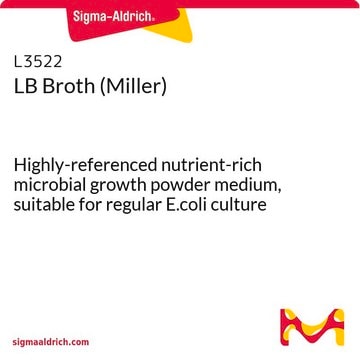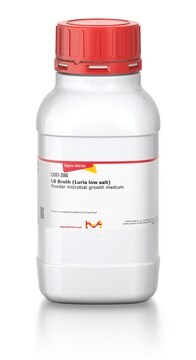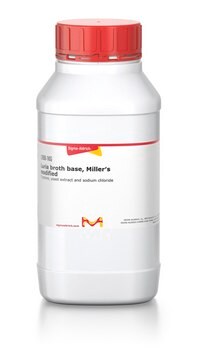L2542
LB Broth (Miller)
Liquid microbial growth medium
Synonym(s):
Luria Broth Miller, Luria-Bertani broth, Miller
Sign Into View Organizational & Contract Pricing
All Photos(1)
About This Item
UNSPSC Code:
41106200
NACRES:
NA.85
Recommended Products
grade
for molecular biology
sterility
sterile; 0.2 μm filtered
form
liquid
technique(s)
microbiological culture: suitable
pH
6.5-7.2
application(s)
microbiology
storage temp.
room temp
suitability
nonselective for Escherichia coli
nonselective for coliforms
General description
Miller’s LB is a highly-referenced microbial growth medium used for the cultivation of E. coli. This nutrient-rich microbial broth contains peptides, amino acids, water-soluble vitamins, and carbohydrates. It enables fast growth, improves growth yields for various bacterial species, and can retain the hydrophilic behavior of samples for longer periods.
Application
LBBroth (Miller) is suitable for:
- non-selective cultivation of E. coli strains for cloning, DNA plasmid production and production of recombinant proteins.
- selective cultivation when appropriate antibiotics are added.
- the cultivation of E-coli cells for anti-bacterial assays.
Features and Benefits
Miller′s LB liquid provides:
- Filter-sterilized, ready-to-use format
- Convenient package size
- Standard formulation
Components
10g/L Tryptone
10 g/L NaCl
5 g/L Yeast Extract
10 g/L NaCl
5 g/L Yeast Extract
related product
Product No.
Description
Pricing
Storage Class Code
12 - Non Combustible Liquids
WGK
nwg
Flash Point(F)
Not applicable
Flash Point(C)
Not applicable
Personal Protective Equipment
dust mask type N95 (US), Eyeshields, Gloves
Choose from one of the most recent versions:
Already Own This Product?
Find documentation for the products that you have recently purchased in the Document Library.
Customers Also Viewed
D O Chaffin et al.
Journal of bacteriology, 187(13), 4615-4626 (2005-06-22)
Several bacterial pathogens have evolved the means to escape immune detection by mimicking host cell surface carbohydrates that are crucial for self/non-self recognition. Sialic acid, a terminal residue on these carbohydrates, inhibits activation of the alternate pathway of complement by
Thomas P Burg et al.
Nature, 446(7139), 1066-1069 (2007-04-27)
Nanomechanical resonators enable the measurement of mass with extraordinary sensitivity. Previously, samples as light as 7 zeptograms (1 zg = 10(-21) g) have been weighed in vacuum, and proton-level resolution seems to be within reach. Resolving small mass changes requires
Use of the Yeast Pichia pastoris as an Expression Host for Secretion of Enterocin L50, a Leaderless Two-Peptide (L50A and L50B) Bacteriocin from Enterococcus faecium L50
Antonio Basanta, Beatriz Gomez-Sala, et al.
Biotechnology, 76, 3314-3324 (2010)
Philippe M Fortune et al.
American journal of botany, 95(4), 454-464 (2008-04-01)
The origin of polyploid Bromus species of section Genea was investigated using molecular data. This group of annual species native from the Old-World is composed of three diploids, two tetraploids, one hexaploid, and one octoploid. Molecular cloning, sequencing, and phylogenetic
Felix Wezel et al.
International journal of molecular sciences, 22(6) (2021-04-04)
Invasive urothelial carcinomas of the bladder (UCB) characteristically show a loss of differentiation markers. The transcription factor Grainyhead-like 3 (GRHL3) plays an important role in the development and differentiation of normal urothelium. The contribution to UCB progression is still elusive.
Our team of scientists has experience in all areas of research including Life Science, Material Science, Chemical Synthesis, Chromatography, Analytical and many others.
Contact Technical Service










